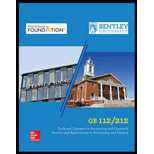
GB 112/212 MANAGERIAL ACC. W/ACCESS >C<
17th Edition
ISBN: 9781260218831
Author: Libby
Publisher: MCG CUSTOM
expand_more
expand_more
format_list_bulleted
Concept explainers
Textbook Question
Chapter 6, Problem 9MCQ
Which of the following best describes the proper presentation of
- a. Gross accounts receivable plus the allowance for doubtful accounts in the asset section of the
balance sheet . - b. Gross accounts receivable in the asset section of the balance sheet and the allowance for doubtful accounts in the expense section of the income statement.
- c. Gross accounts receivable less
bad debt expense in the asset section of the balance sheet. - d. Gross accounts receivable less the allowance for doubtful accounts in the asset section of the balance sheet.
Expert Solution & Answer
Want to see the full answer?
Check out a sample textbook solution
Students have asked these similar questions
Please explain the solution to this financial accounting problem with accurate principles.
Compute the direct labor cost variance
give me answer general accounting question
Chapter 6 Solutions
GB 112/212 MANAGERIAL ACC. W/ACCESS >C<
Ch. 6 - Prob. 1QCh. 6 - What is gross profit or gross margin on sales? In...Ch. 6 - What is a credit card discount? How does it affect...Ch. 6 - Prob. 4QCh. 6 - Prob. 5QCh. 6 - Differentiate accounts receivable from notes...Ch. 6 - Which basic accounting principle is the allowance...Ch. 6 - Using the allowance method, is bad debt expense...Ch. 6 - Prob. 9QCh. 6 - Prob. 10Q
Ch. 6 - Prob. 11QCh. 6 - Prob. 12QCh. 6 - Prob. 13QCh. 6 - Prob. 14QCh. 6 - Briefly explain how the total amount of cash...Ch. 6 - Prob. 16QCh. 6 - Sales discounts with terms 2/10, n/30 mean: a. 10...Ch. 6 - Gross sales total 300,000, one-half of which were...Ch. 6 - A company has been successful in reducing the...Ch. 6 - When a company using the allowance method writes...Ch. 6 - You have determined that Company X estimates bad...Ch. 6 - Prob. 6MCQCh. 6 - Which of the following is not a step toward...Ch. 6 - When using the allowance method, as bad debt...Ch. 6 - Which of the following best describes the proper...Ch. 6 - Prob. 10MCQCh. 6 - Prob. 6.1MECh. 6 - Prob. 6.2MECh. 6 - Recording Bad Debts Prepare journal entries for...Ch. 6 - Prob. 6.4MECh. 6 - Determining the Effects of Credit Policy Changes...Ch. 6 - Prob. 6.6MECh. 6 - Prob. 6.7MECh. 6 - Prob. 6.1ECh. 6 - Reporting Net Sales with Credit Sales, Sales...Ch. 6 - Reporting Net Sales with Credit Sales, Sales...Ch. 6 - Determining the Effects of Credit Sales, Sales...Ch. 6 - Prob. 6.5ECh. 6 - Reporting Bad Debt Expense and Accounts Receivable...Ch. 6 - Recording Bad Debt Expense Estimates and...Ch. 6 - Recording Bad Debt Expense Estimates and...Ch. 6 - Prob. 6.9ECh. 6 - Prob. 6.10ECh. 6 - Computing Bad Debt Expense Using Aging Analysis...Ch. 6 - Recording and Reporting a Bad Debt Estimate Using...Ch. 6 - Recording and Reporting a Bad Debt Estimate Using...Ch. 6 - Prob. 6.14ECh. 6 - Prob. 6.15ECh. 6 - Inferring Bad Debt Write-Offs and Cash Collections...Ch. 6 - Inferring Bad Debt Write-Offs and Cash Collections...Ch. 6 - Prob. 6.18ECh. 6 - Prob. 6.19ECh. 6 - Prob. 6.20ECh. 6 - Recording, Reporting, and Evaluating a Bad Debt...Ch. 6 - Prob. 6.22ECh. 6 - Prob. 6.23ECh. 6 - Interpreting tho Effects of Salos Declines and...Ch. 6 - Prob. 6.25ECh. 6 - Prob. 6.26ECh. 6 - Prob. 6.27ECh. 6 - Prob. 6.1PCh. 6 - Recording Bad Debts and Interpreting Disclosure of...Ch. 6 - Determining Bad Debt Expense Based on Aging...Ch. 6 - Preparing an Income Statement and Computing the...Ch. 6 - Prob. 6.5PCh. 6 - Prob. 6.6PCh. 6 - Prob. 6.7PCh. 6 - Reporting Net Sales and Expenses with Discounts,...Ch. 6 - Prob. 6.2APCh. 6 - Determining Bad Debt Expense Based on Aging...Ch. 6 - Prob. 6.4APCh. 6 - Prob. 6.5APCh. 6 - Prob. 6.1CONCh. 6 - Finding Financial Information Refer to the...Ch. 6 - Finding Financial Information Refer to the...Ch. 6 - Prob. 6.3CPCh. 6 - Prob. 6.4CPCh. 6 - Prob. 6.5CP
Knowledge Booster
Learn more about
Need a deep-dive on the concept behind this application? Look no further. Learn more about this topic, accounting and related others by exploring similar questions and additional content below.Similar questions
- A new machine with a purchase price of$90,000, transportation costs of $8,000, installation costs of $6,000, and special handling fees of $2,000, would have a cost basis of:arrow_forwardCan you solve this general accounting problem using appropriate accounting principles?arrow_forwardI need guidance with this general accounting problem using the right accounting principles.arrow_forward
arrow_back_ios
SEE MORE QUESTIONS
arrow_forward_ios
Recommended textbooks for you
- Principles of Accounting Volume 1AccountingISBN:9781947172685Author:OpenStaxPublisher:OpenStax College
 Auditing: A Risk Based-Approach (MindTap Course L...AccountingISBN:9781337619455Author:Karla M Johnstone, Audrey A. Gramling, Larry E. RittenbergPublisher:Cengage Learning
Auditing: A Risk Based-Approach (MindTap Course L...AccountingISBN:9781337619455Author:Karla M Johnstone, Audrey A. Gramling, Larry E. RittenbergPublisher:Cengage Learning

Principles of Accounting Volume 1
Accounting
ISBN:9781947172685
Author:OpenStax
Publisher:OpenStax College

Auditing: A Risk Based-Approach (MindTap Course L...
Accounting
ISBN:9781337619455
Author:Karla M Johnstone, Audrey A. Gramling, Larry E. Rittenberg
Publisher:Cengage Learning
Accounts Receivable and Accounts Payable; Author: The Finance Storyteller;https://www.youtube.com/watch?v=x_aUWbQa878;License: Standard Youtube License